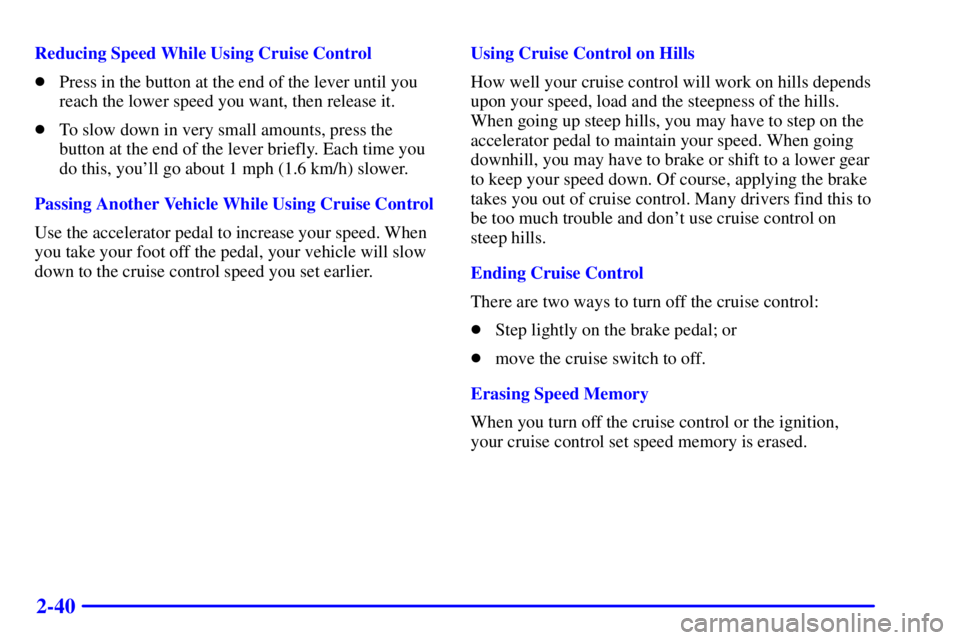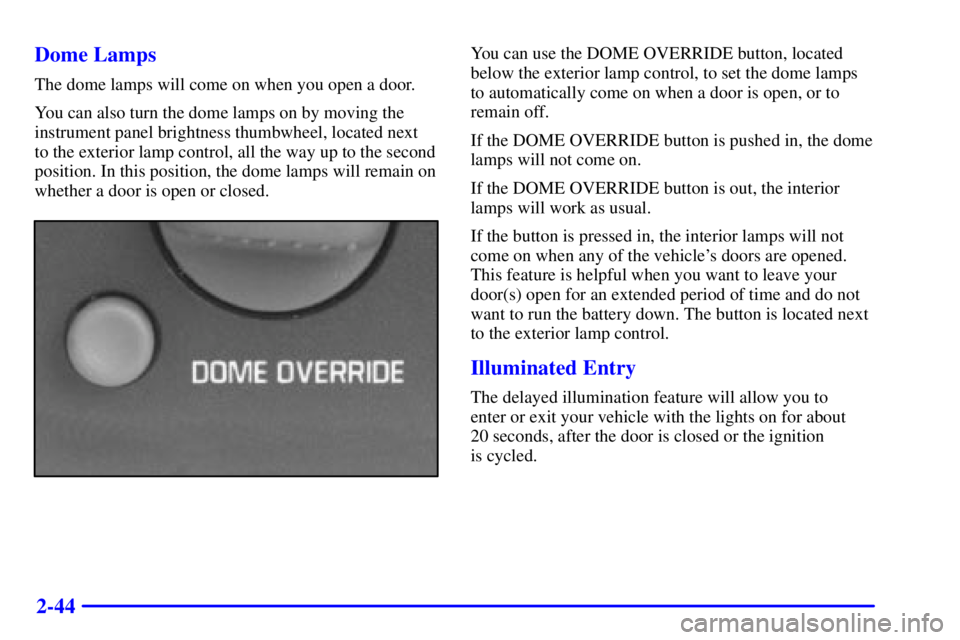Page 98 of 411
2-27
Parking Brake
To set the parking brake, hold the regular brake pedal
down with your right foot. Push down the parking brake
pedal with your left foot.
If the ignition is on, the brake system warning light will
come on.
To release the parking brake, hold the regular brake
pedal down. Pull the handle, located just above the
parking brake pedal, marked BRAKE RELEASE to
release the parking brake.
If the ignition is on when the parking brake is released,
the brake system warning light will go off.
NOTICE:
Driving with the parking brake on can cause
your rear brakes to overheat. You may have to
replace them, and you could also damage other
parts of your vehicle. Always check to be sure
your parking brake is fully released before
you drive.
If you are towing a trailer and are parking on any hill,
see ªTowing a Trailerº in the Index. That section shows
what to do first to keep the trailer from moving.
Page 106 of 411

2-35 Turn and Lane Change Signals
The turn signal has two upward (for right) and two
downward (for left) positions. These positions allow you
to signal a turn or a lane change.
To signal a turn, move the lever all the way up or down.
When the turn is finished, the lever will return automatically.
An arrow on the instrument
panel cluster will flash in
the direction of the turn
or lane change.
To signal a lane change, just raise or lower the lever
until the arrow starts to flash. Hold it there until you
complete your lane change. The lever will return by
itself when you release it.As you signal a turn or a lane change, if the arrows flash
at twice the normal rate, a signal bulb may be burned
out and other drivers may not see your turn signal.
If a bulb is burned out, replace it to help avoid an
accident. If the arrows don't go on at all when you
signal a turn, check for burned
-out bulbs and a blown
fuse (see ªFuses and Circuit Breakersº in the Index).
Headlamp High/Low-Beam Changer
To change the headlamps from low beam to high or high
to low, pull the multifunction lever all the way toward
you. Then release it.
When the high beams
are on, this light on the
instrument panel cluster
also will be on.
Page 107 of 411

2-36 Windshield Wipers
You control the windshield wipers by turning the band
with the wiper symbol on it.
(Off): Turn the band to this symbol to turn off the
windshield wipers.
(Mist): Turn the band to this symbol for a single
wiping cycle. Hold it there until the windshield wipers
start; then let it go. The windshield wipers will stop after
one wipe. If you want more wipes, hold the band on
mist longer.
Turn the band upward to choose one of the five delay
settings. For more wipes select a higher setting; for
fewer wipes select a lower setting. The further the band
is turned upward, the shorter the delay between wipes.
Use this setting for light rain or snow.
(Low Speed): Turn the band downward to the first
solid band and past the delay settings, for steady wiping
at low speed.
(High Speed): Turn the band down further to the
second solid band and past the delay settings, for steady
wiping at high speed.
Be sure to clear ice and snow from the wiper blades
before using them. If they are frozen to the windshield,
carefully loosen or thaw them. If your blades do become
worn or damaged, get new blades or blade inserts.Heavy snow or ice can overload your wipers. The
windshield wiper motor is protected from overload by
a circuit breaker and a fuse. If the motor overheats due
to heavy snow or ice the wiper will stop until the motor
cools. Although the circuit is protected from electrical
overload, overload due to heavy snow or ice may cause
wiper linkage damage. Always clear ice and heavy snow
from the windshield before using your windshield wipers.
Windshield Washer
(Washer Fluid): There is a paddle marked with the
windshield washer symbol at the top of the multifunction
lever. To spray washer fluid on the windshield, press the
paddle. The wipers will clear the window and then either
stop or return to your preset speed.
CAUTION:
In freezing weather, don't use your washer until
the windshield is warmed. Otherwise the washer
fluid can form ice on the windshield, blocking
your vision.
Page 111 of 411

2-40
Reducing Speed While Using Cruise Control
�Press in the button at the end of the lever until you
reach the lower speed you want, then release it.
�To slow down in very small amounts, press the
button at the end of the lever briefly. Each time you
do this, you'll go about 1 mph (1.6 km/h) slower.
Passing Another Vehicle While Using Cruise Control
Use the accelerator pedal to increase your speed. When
you take your foot off the pedal, your vehicle will slow
down to the cruise control speed you set earlier.Using Cruise Control on Hills
How well your cruise control will work on hills depends
upon your speed, load and the steepness of the hills.
When going up steep hills, you may have to step on the
accelerator pedal to maintain your speed. When going
downhill, you may have to brake or shift to a lower gear
to keep your speed down. Of course, applying the brake
takes you out of cruise control. Many drivers find this to
be too much trouble and don't use cruise control on
steep hills.
Ending Cruise Control
There are two ways to turn off the cruise control:
�Step lightly on the brake pedal; or
�move the cruise switch to off.
Erasing Speed Memory
When you turn off the cruise control or the ignition,
your cruise control set speed memory is erased.
Page 112 of 411
2-41
Exterior Lamps
The exterior lamp control is located on the driver's side
of the instrument panel.The exterior lamp control has three positions:
OFF: Turning the control to this position turns off all
lamps except the Daytime Running Lamps (DRL).
(Parking Lamps): Turning the control to
this position turns on the parking lamps, together with
the following:
�Sidemarker Lamps
�Taillamps
�License Plate Lamps
�Instrument Panel Lights
�Ashtray Lamp
(Headlamps): Turning the control to this position
turns on the headlamps, together with the previously
listed lamps and lights.
You can change your headlamps from high to low beam
by pulling on the turn signal/high beam lever.
A circuit breaker protects your headlamps. If you have
an electrical overload, your headlamps will flicker on
and off. Have your headlamp wiring checked right away
if this happens.
Page 113 of 411

2-42
Headlamps On Reminder
A tone will sound when your headlamps are turned on
and your ignition is in OFF, LOCK or ACCESSORY.
If you need to use your headlamps when the ignition
switch is in OFF, LOCK or ACCESSORY, the tone
can be turned off by moving the instrument panel
brightness thumbwheel next to the exterior lamp control
all the way down.
Daytime Running Lamps
Daytime Running Lamps (DRL) can make it easier
for others to see the front of your vehicle during the
day. DRL can be helpful in many different driving
conditions, but they can be especially helpful in the
short periods after dawn and before sunset. Fully
functional daytime running lamps are required on
all vehicles first sold in Canada.The DRL system will make your headlamps come on
at a reduced brightness when the following conditions
are met:
�The ignition is on,
�The exterior lamp control is off, and
�The parking brake is released.
When the DRL are on, only your headlamps will be on.
The taillamps, sidemarker and other lamps won't be on.
Your instrument panel won't be lit up either.
When it begins to get dark, your DRL indicator light is a
reminder to turn the headlamps on. The other lamps that
come on with your headlamps will also come on.
When you turn off the headlamps, the regular lamps will
go off, and your headlamps will change to the reduced
brightness of DRL.
To idle your vehicle with the engine on and the DRL off,
set the parking brake. The DRL will stay off until you
release the parking brake.
As with any vehicle, you should turn on the regular
headlamp system when you need it.
Page 114 of 411
2-43 Center High-Mounted Stoplamp
Your vehicle's center high-mounted stoplamp is located
above the rear doors at the center of the vehicle.
If items are loaded on the roof of the vehicle, as in a
luggage carrier, care should be taken not to block or
damage the center high
-mounted stoplamp unit.
Interior Lamps
Instrument Panel Brightness Control
This feature controls the brightness of the instrument
panel lights.
The thumbwheel for this feature is located to the right
of the exterior lamps control.
Turn the thumbwheel up to brighten the lights. When the
thumbwheel is moved to the first position, the radio
display and transmission selection display will go to full
intensity. The instrument panel cluster will be dimly lit.
Moving the thumbwheel up to the next position will
activate the interior dome lamps
Page 115 of 411

2-44 Dome Lamps
The dome lamps will come on when you open a door.
You can also turn the dome lamps on by moving the
instrument panel brightness thumbwheel, located next
to the exterior lamp control, all the way up to the second
position. In this position, the dome lamps will remain on
whether a door is open or closed.
You can use the DOME OVERRIDE button, located
below the exterior lamp control, to set the dome lamps
to automatically come on when a door is open, or to
remain off.
If the DOME OVERRIDE button is pushed in, the dome
lamps will not come on.
If the DOME OVERRIDE button is out, the interior
lamps will work as usual.
If the button is pressed in, the interior lamps will not
come on when any of the vehicle's doors are opened.
This feature is helpful when you want to leave your
door(s) open for an extended period of time and do not
want to run the battery down. The button is located next
to the exterior lamp control.
Illuminated Entry
The delayed illumination feature will allow you to
enter or exit your vehicle with the lights on for about
20 seconds, after the door is closed or the ignition
is cycled.